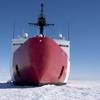El Faro's Master: 'We're gettin' conflicting reports'
The captain of a U.S.-flagged cargo ship that sank near the Bahamas last year, killing all 33 onboard, told a crew member that there was confusion about the location of the storm that doomed the vessel, a transcript released on Tuesday shows.
The 790-foot (240-meter) El Faro sank on the morning of Oct. 1, 2015 in the worst cargo shipping disaster involving a U.S.-flagged vessel in more than three decades.
The National Transportation Safety Board released the 510-page transcript and other data about the wreck, but said it was not yet ready to identify the cause behind the sinking, which came during a routine cargo run between Jacksonville, Florida, and Puerto Rico.
"We're gettin' conflicting reports as to where the center of the storm is," the captain, Michael Davidson, told his chief mate at 5:03 a.m., according to the transcript. The alarm to abandon ship sounded about 2-1/2 hours later.
The transcript, covering 10 hours and drawn from six microphones on the ship's bridge, may be crucial in determining why the ship sailed close to the storm's center and why it was unable to withstand it, NTSB officials said at a news conference broadcast online.
But the transcript is also fractured, they said. In the crucial hours before the deadly sinking, it is pocked with conversations that investigators could not entirely make out because of background noise or distance from microphones.
One question investigators are trying to answer is which weather data the El Faro crew relied on. Davidson received data by email that was six hours behind other information the crew received, officials said.
"There were many sources of weather information. In establishing what was likely viewed by various members of the crew at specific times during the voyage, that is part of the NTSB's ongoing investigation," James Ritter, director of the NTSB's Office of Research and Engineering, said at the news conference.
A data recorder, including the voice recording from the bridge, was recovered from the wreckage about 15,000 feet (4,600 meters) below the surface of the ocean.
Thomson Reuters Eikon data previously revealed that the El Faro was sailing at near full speed into the center of the storm, raising questions about the captain's voyage plan.
Reporting by David Ingram











